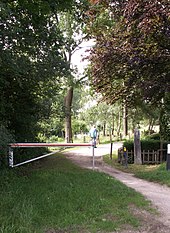Green border

The course of internationally recognized land borders between the approved border crossing points is referred to as the green border . The term also includes the boundary through or along inland waters.
The term “green border” is derived from the borderline in nature. It has nothing to do with the fact that the border is not secured or monitored. In the 1990s, for example, certain organizational units of the former Federal Border Police (now the Federal Police ) were referred to as the “Green Border” section, and these offices correspond roughly to an area responsible for border surveillance. The term blue border is also used for the borderline on the water.

The borders between the member states of the Schengen Agreement in the EU (internal border) have also been colloquially referred to as "green borders" since border controls were discontinued.
According to Article 22 of the Schengen Borders Code , crossing the Schengen internal borders is permitted at any point without personal control, regardless of the nationality of the person concerned.
See also
Footnotes
- ↑ Dietrich Heesen, Jürgen Hönle, Andreas Peilert: Federal Border Guard Act - Administrative Enforcement Act - Act on Immediate Compulsion: Commentary , VDP - Verlag Deutsche Polizeiliteratur, Hilden 2002, ISBN 978-3-8011-0442-9 .
- ↑ Text of the regulation (PDF) , see also Article 3.